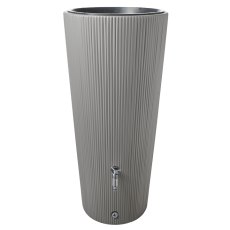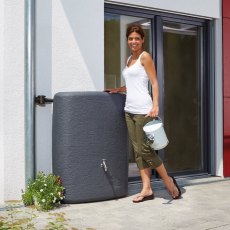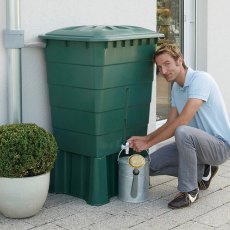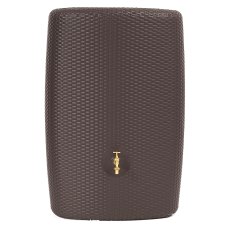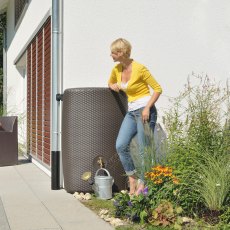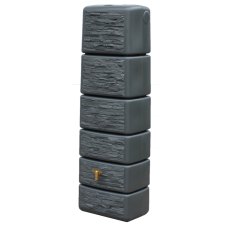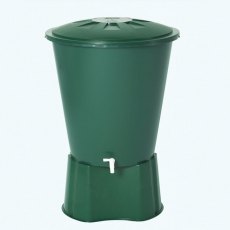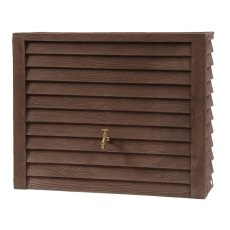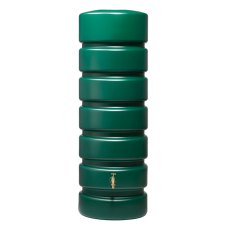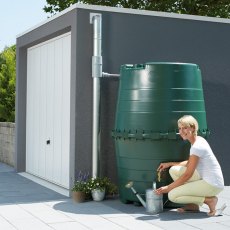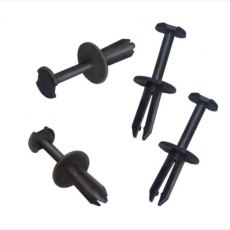Water Butts
If you are looking to conserve water and save money on your water bills, a high-quality water butt from Tanks.ie can help you collect and store rainwater to use in your garden, conservatory, or for other outdoor purposes.
Our water butts are designed to help you make a positive impact on the environment. By collecting rainwater, you can reduce your reliance on tap water and reduce the strain on local water supplies. You’ll be doing your part to protect the environment and reduce your water consumption while enjoying the benefits of free, natural rainwater. We offer a range of water butts in various sizes and styles to suit your specific needs – whether it’s a compact water butt for a small garden or patio, or a large water butt for more extensive gardening or outdoor water needs. Rainwater is naturally soft and free from harsh chemicals, making it ideal for watering plants. Enjoy environmentally friendly gardening practices by using rainwater from a garden water butt that promotes healthy plant growth without introducing potentially harmful chemicals to your garden.
Made from high-quality materials, our water butts are built to last and designed to withstand the elements. By using rainwater from a water butt, you can also save money on your water bills.
Three main considerations for choosing a water butt is the material the water butt is made from, the size of water butt you need and the price you wish to pay. two of our best sellers are the 300L Square Water Butt and the 310L Round Water Butt
Water Butt Installation:
- Select a suitable downpipe to connect your water butt to by using a downpipe filter or diverter. To see our range of filters and diverters go to Rainwater Accessories.
- Drill a hole in the water butt around 80 to 100mm from the top on the correct side of the water butt to the downpipe
- Secure the hose connector to this hole
- Fit the downpipe diverter or rainwater filter to the downpipe at the correct height to allow the diverter to connect into the water butt
- Attach a flexible piece of hose from the diverter to the water butt connection.
Water Butts FAQs
What type of water tank do I need?
At Tanks.ie, we stock a range of different water tanks. From rainwater harvesting to wastewater treatment, there are water tanks designed for all types of water storage. The type of water tank you need will depend on what you plan to use it for.
If you are storing drinking water, you will need a potable water tank, like these GRP tanks. They are suitable for storing clean water that is fit for human consumption, prepping food and cleaning dishes. They meet government approved standards and regulations for the safe storage of drinking water. Non-potable water tanks store water that can be used for other purposes like flushing toilets and watering plants but is not safe for human consumption.
If you’re storing hazardous materials or liquids, check out our range of IBCs (Intermediate Bulk Containers) or if you’re working in the agricultural, farming or horticulture sector, you may want to have a look at our agricultural water tanks that are built to withstand the changeable outdoor environment. Our rainwater harvesting tanks are great for collecting and storing rainwater, that can then be used to flush your toilets and wash your clothes.
We have many more types of water tanks available at Tanks.ie. If you’d like any help and advice choosing your water tank, don’t hesitate to contact our friendly team.
Do I need to insulate my cold-water storage tanks?
Insulating your cold-water storage tank is a wise decision with several benefits. The primary reason to insulate is to prevent heat loss from the water inside the tank. During colder seasons, especially in the Irish climate, uninsulated tanks can experience a drop in temperature, potentially leading to issues like freezing. Insulating your cold-water storage tank helps to maintain a more stable water temperature, reducing the risk of freezing and ensuring a reliable water supply.
By minimising heat loss, you can reduce the energy required to heat the water, which is particularly important if you have a water heating system connected to the tank. This energy-saving aspect not only promotes sustainability but also reflects positively on your utility bills, providing a cost-effective solution in the long run. Regulations often recommend or mandate specific insulation measures to enhance energy efficiency and prevent common issues associated with cold water storage. Ensuring your tank meets these regulations not only keeps you in compliance but also guarantees that your water system operates efficiently and safely.
How long do cold water storage tanks last?
Typically, well-maintained cold water storage tanks crafted from durable materials like polyethylene can last anywhere from 20 to 30 years. The high-quality construction of the tanks sold at Tanks.ie contributes significantly to their longevity, with resistance to corrosion and wear-and-tear ensuring reliable performance over an extended period.
Your proactive involvement in regular maintenance plays a crucial role in determining the lifespan of the tank. Timely inspections for signs of damage, leaks, or structural issues can significantly prolong the tank's functionality. Regularly checking fittings, valves, and the integrity of the tank structure is essential to catch and address potential issues before they escalate.
Exposure to extreme temperatures, UV radiation, or harsh chemicals can accelerate wear. Proper installation and placement in a sheltered, well-ventilated area contribute to the tank's overall resilience.
How much does it cost to install a water storage tank?
Water tank installation and replacement costs can vary greatly based on several factors.
First, you’ll want to consider the cost of the tank itself. The bigger the tank, the bigger the price tag. The material the tank is made of will also impact the cost, with metal water tanks costing slightly more than plastic ones.
When it comes to the installation, underground water tanks generally cost more to install than above ground water tanks. Underground water tanks need an excavation crew to dig out the area where the tank will go, so you will need to factor in the cost of labour to do this. If you are installing a cold-water storage tank in an attic, the biggest challenge is getting the tank inside the loft through the loft hatch and removing the old tank. Ease and accessibility will play an enormous factor in the final cost.
Finally, you will need to consider the cost of a plumber to connect the pipes. If you’re wanting any additional add-ons for your water tank, such as booster pumps to increase the water pressure, there may be additional costs to consider.
We recommend consulting your local council and homeowners' association to ensure that your water tank installation meets all the required guidelines.
How long should a water storage tank last?
There are many factors that can affect how long a water tank should last:
- Usage
The purer the water you’re storing in your tank, the longer your tank is likely to last. For example, if you’re storing salt water, there is a much higher risk of corrosion and damage to the tank. Clean water is much less likely to damage your tank.
- Materials
Most water tanks will be made from either plastic or metal. Plastic tanks are non-biodegradable so it shouldn’t break down over time. For this reason, you should use a specialist waste disposal company at the end of your tank’s life. A good quality polymer plastic water tank should last between ten and twenty years. Metal water tanks are usually made from steel which can be melted down and recycled at the end of its life. A steel tank should last over 30 years.
- Location
Where your tank is located could also affect its lifespan. If your water tank is stood in water, it could damage it, so try to ensure your tank is placed on a solid foundation. The UV treatment on plastic tanks can also be reduced if exposed to long hours of direct sunlight.
What’s a potable water tank?
Water tanks can be classified as ‘potable’ and ‘non potable’. If you are storing clean water for human consumption, whether it be for drinking, prepping food or cleaning dishes etc, then a potable water tank is what you are after. All potable tanks must conform to the WRAS (Water Regulations Advisory Scheme) so that the liquid is safe for human consumption.
Non-potable tanks are for the safe storage of non-drinking water or for ‘not suitable’ for human consumption, in many different environments and applications. Non-potable tanks can be used in applications like rainwater harvesting, irrigation, agriculture & horticulture and commercial purposes where mains water is not available.
The difference in classification between the two comes from the materials used during the manufacturing process, specifically the type of plastic used to line the inside of the tank which comes into contact with the contained water. Non potable tanks are more porous, making it easier for the bacteria to grow and can sometimes let off gases which can contaminate the water. The WRAS approved material lines the inside of the tank, making the tank fit for human consumption, either ingested or used on the skin.
What is the difference between Potable and Non-Potable water tanks?
A potable water tank is suitable for storing drinking water and must adhere to specific government regulations. A non-potable water tank stores water that can be used for other purposes like flushing toilets and watering plants but is not safe for human consumption.
All potable water tanks, like these GRP tanks, must be submitted to the WRAS for testing, approval and accreditation and be approved in line with the Water Supply (Water Fittings) Regulations 1999. Potable water tanks are usually constructed from food-grade polyethene and finished with a smooth interior to protect against bacteria growth. Our potable water tanks come in a wide range of capacities, from 4 litre to 250,000 litre.
Non-potable tanks store water that can be used for plumbing purposes, such as flushing the toilet and in washing machines, as well as for gardening. They are often used in industrial and commercial premises, horticultural and market garden applications, agricultural irrigation and civil engineering situations where mains water is not available. In fact, non-potable water tanks are suitable for any application where the water or liquid stored will not be consumed by humans or animals.
What materials are the plastic tanks manufactured from?
Plastic water tanks can be made of lots of different materials, however the majority of tanks we offer are made from either a medium density polyethylene (MDPE) or a high density polyethylene.
What outlet do I require?
The majority of our water tanks come with an outlet as standard. We can offer a range of water tanks where the tanks can either ‘Drilled’ or ‘Undrilled’. ‘Drilled’ meaning allowing water to escape from the tank via the outlet, whereas ‘Undrilled’ is when the outlet will remain sealed, preventing liquid from coming out and ensuring the contents of the tank is only touching plastic.
If the position of the outlet is required in an alternative position to the standard one offered or extra to the one positioned, we can offer a plastic Fusion socket. This can be welded anywhere on the tank using a drawing supplied by us, positions marked out by you, then fitted by the manufacturer.
Plain tanks (with no outlets) can also be offered.
If you require a plastic fusion socket or a plain tank, then please contact our Customer Service Team, who will be happy to help with your requirements.
Tap or hose tail kits, what’s the difference and when would I need one?
We offer a range of tap kits, each displaying the size of the hosetail and the outlet size the kit will suit. Tap Kit 5 (TPK5) is the best solution if you require a garden hose to be fitted. Our range of Hosetail kits allows you to attach a hose or pipe to the tank, leak-free. They are designed for continuous flow and come in varying sizes depending on the outlet.
All our tap kits come with a Jubilee clip and PDFE tape for that secure fit.
What’s a standard hose pipe size?
UK hose pipe diameters range from ½” to ¾” inch diameters. The majority of standard size garden hoses are 3/4” BSP, however we do offer accessories for the ½” hose, if required.
Baffled Water tanks, what are they and when are they recommended?
Baffled water tanks are tanks with an intergral wall system, which is primarily designed to strengthen and support the structure of the tank, when the tank is full of water.
Due to the structure of the baffles they can also be used for transporting water. The Baffles distrupt the movement of water, from surging from one side to the other. However, if you are transporting water, water tanks can be extremely hazardous when transporting large volumes of water. Please make sure the water tanks are installed and secured correctly, by a suitable qualified person before transportation. Baffled water tanks are an ideal solutions for car valeters, window cleaners or anyone who has to transport liquids using plastic water storage tanks and containers.
What are the benefits of having a water butt?
A water butt, also known as a rain barrel, is a container used to collect and store rainwater that falls on rooftops. There are several benefits to having a water butt. Collecting rainwater in a water butt allows you to reuse it for various purposes, such as watering your plants, washing your car, or cleaning outdoor spaces. This reduces your reliance on tap water, which is often treated and requires energy for purification and distribution. Using rainwater from a water butt can help conserve water and reduce your overall water usage, leading to cost savings on your water bill.
Rainwater is naturally soft and free from the chemicals commonly found in tap water, such as chlorine and fluorine. Using rainwater collected in a water butt for watering your plants provides them with natural, untreated water, which can be healthier for their growth and development.
During periods of water scarcity or drought, having a water butt can provide you with a stored source of water for essential outdoor tasks, such as watering your garden or washing your car, even when water restrictions may be in place. This can help you maintain your outdoor spaces and reduce your impact on local water resources during times of water shortage.
How does a water butt work?
A water butt is typically positioned under a downpipe or gutter on your roof. When it rains, water from the roof flows into the gutter and down the downpipe, and then into the water butt through a diverter or downpipe connector. Some water butts may also have a built-in filter to prevent debris, such as leaves and twigs, from entering the water butt and contaminating the stored water.
Once the rainwater enters the water butt, it is stored in the container until you are ready to use it. At Tanks Direct, we offer a range of water butts in various sizes, from 110 to 340 litres. Water butts are typically equipped with a tap or a hose attachment near the bottom of the container, allowing you to access the collected water easily. Some water butts may also have an overflow outlet near the top to prevent overflow during heavy rainfall.
You can use the stored rainwater in your water butt for various purposes, such as watering your plants, washing your car, or cleaning outdoor spaces. Depending on the design of your water butt, you can either use a tap to fill watering cans or connect a hose to the hose attachment to distribute the water directly to your garden or other areas.
How long can you keep water in a water butt?
The length of time you can keep water in a water butt depends on various factors, such as the size and material of the water butt and the quality of the collected rainwater. In general, rainwater stored in a properly maintained water butt can be kept for several weeks to several months. However, it's important to note that rainwater is not treated or purified, and over time, it may become stagnant or develop algae, which can affect its quality.
The quality of the rainwater collected in a water butt can vary depending on factors such as air pollution, debris, and contaminants from the roof or gutters. It's recommended to use a water butt with a built-in filter or add a filter attachment to the downpipe to help minimise debris and contaminants from entering the water butt. Regularly checking and cleaning the water butt, including the filter, can help maintain water quality.
If you use the stored rainwater in your water butt regularly for watering plants or other purposes, the water turnover will be higher, and the water is less likely to stagnate. Using the collected rainwater regularly can help ensure that the water remains fresh and reduces the risk of water quality issues.
Regular maintenance of the water butt is important to ensure the water remains clean and fresh. This includes checking the water butt for debris or sediment build-up, cleaning the container and filter as needed, and ensuring that the tap or hose attachment is in good working condition. Following the manufacturer's instructions for maintenance and cleaning is recommended.
It's generally recommended to use up the stored rainwater in a water butt within a few weeks to a few months to ensure optimal water quality. If you have concerns about water quality or if the water in your water butt appears discoloured, has an odour, or shows signs of contamination, it's best to discard the water and clean the water butt thoroughly before collecting new rainwater.
Can you drink rainwater from a water butt?
While rainwater is generally considered safe for many uses, including watering plants and cleaning outdoor spaces, it's not recommended to drink rainwater from a water butt without proper treatment. Rainwater collected in a water butt is not typically treated or purified and may contain various contaminants that can pose health risks if ingested.
Rainwater can pick up contaminants from the roof, gutters, and other surfaces as it flows into the water butt, including dust, pollen, bird droppings, leaves, and other debris. In addition, air pollution and environmental contaminants can also be present in rainwater, especially in urban areas. These contaminants can potentially affect the quality of the collected rainwater and make it unsafe for drinking without proper treatment.
How to install a water butt?
Installing a water butt involves several steps to ensure proper setup and functionality.
- Select a location for your water butt that is close to a downpipe or a rainwater source, such as a roof or gutter. The area should be level and stable to support the weight of the water butt when full. Consider accessibility for maintenance and ease of use, such as attaching a hose or filling watering cans.
- Clear the area of any debris, vegetation, or obstacles that may interfere with the installation or use of the water butt. Ensure that the ground is level and stable.
- Install a rainwater diverter to divert water from a downpipe into the water butt. Follow the manufacturer's instructions to install the diverter, which typically involves cutting a section of the downpipe and attaching the diverter using screws or clips. Make sure the diverter is securely fitted and positioned properly to direct water into the water butt.
- Place the water butt in the chosen location and ensure that it is level and stable. If the water butt has a stand or pedestal, assemble it according to the manufacturer's instructions. Some water butts may also require additional brackets or supports for stability.
- Connect the hose or pipe from the rainwater diverter to the inlet of the water butt. Make sure the connection is tight and secure to prevent leaks.
- If the water butt has an overflow port, it's important to install an overflow pipe or hose to direct excess water away from the water butt and prevent overflow. Follow the manufacturer's instructions to attach the overflow pipe or hose securely and direct it to a suitable drainage area.
- Install a tap or hose attachment at the base of the water butt to allow for easy access to the stored rainwater. Follow the manufacturer's instructions to install the tap or hose attachment securely and ensure that it is positioned properly for convenient use.
- Once the water butt is installed, fill it with water to check for any leaks or drips. Fix any leaks or issues before using the water butt.
You will need to ensure your water butt is properly maintained by regularly checking for debris, cleaning filters or screens, and ensuring that the tap or hose attachment is in good working condition. Follow the manufacturer's instructions for maintenance and cleaning to ensure optimal performance.
What size water tank do I need for my garden?
The size of your water tank really depends on what you want to use the rainwater for. If it is just for watering the garden, your water butt should be reletive to the size of garden you want to water. As a rule of thumb, you will use 8-10 litres of water for every square meter of garden bed and 5 litres for every establishing fruit tree in the summer period everytime you water. However you do not need to store all this water at one as we have usually have a plentiful supply of rainwater in Ireland.
Our range of water butts ranges from 200 litres to 750 litres. If you are looking for a larger storage tank you can check out our range of Titan water tanks.
What do I need to connect my water butt to the drain pipe?
You can use a downpipe filter or diverter to connect a water butt to your drain pipe. To see our range of filters and diverters go to Filters & Siphons.

 Login
Login


